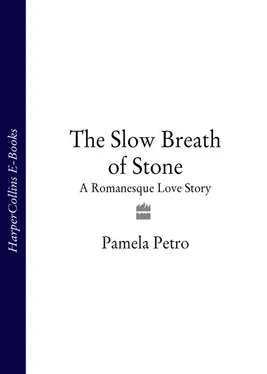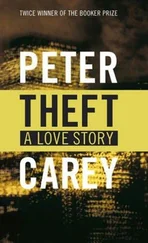A Romanesque Love Story
PAMELA PETRO
For Mary Diaz and Tom Ferguson
and for Richard Newman
Cover
Title Page THE SLOW BREATH OF STONE A Romanesque Love Story PAMELA PETRO
Map of Southwest France Map of Southwest France
Map of the Pilgrimage Road Map of the Pilgrimage Road
1 Discovery
2 Preparations
3 Stones
4 Kingsley and Queensley
5 Maps and Quarries
6 Sculpture
7 The Causses
8 Pilgrimage
9 Racannières
Epilogue
Index
A Note on Sources
Acknowledgements
Also By Pamelo Petro
Copyright
About the Publisher
Map of the Pilgrimage Road
Lend me the stones of the past, and I will lend you the wings of the future.
Robinson Jeffers
Lucy Porter awoke in a meadow outside the town of Espalion. She was unaccustomed to lying in meadows, but the summer of 1920 had been kind to the grass in southwest France, and it was as thick and inviting as any mattress. She propped herself up on an elbow. Perhaps Anfossi, her chauffeur, had jacked up the Fiat to check the patch on their latest puncture. But he was still asleep at a discreet distance in the next field. No matter, she was awake now. Lucy picked up her pen and rolled onto her side, pulling her journal closer. Its filled pages looked like an artist’s rendering of a hedgerow.
‘In the evening,’ she wrote of last night’s after-dinner stroll, ‘to walk by the River Lot. The willows grew in an exact Corot way – a boat with a touch of red in it, would have completed the Metropolitan Museum picture.’
The composition in which she lay was equally satisfying, perhaps more so thanks to the addition of her own small body, her pale dress like a white erasure against the green meadow. In front of her, its solitary bulk dwarfing the town and surrounding river valley, was a great cone of basalt, a volcanic orphan of the Mesozoic Era about eighty million years old, capped by the erratic profile of a ruined château. Behind Lucy lay a more recent, more imaginable past: a cemetery of granite crypts, many topped with vases holding fresh flowers, and, behind the graves, a worn, red church of the eleventh century.
Lucy sat up and looked back at the church of Perse, adjusting the bun at the nape of her neck. Her hair was dark but beginning to grey in weedy strands. She didn’t like it – grey hair reminded her that Kingsley was so much younger – but what did she expect? She was forty-four years old. The church was greying, too. White blotches – what the French called la maladie blanche, secretions of lime oozing from the red sandstone – had broken out over its façade, under the eaves, across the faces of sculpted apostles.
An image in Lucy’s mind, an image framed only a few hours earlier on the focusing plate of her view camera, superimposed itself across the bare western profile of the church. At the time the image had been upside down, but her mind’s eye righted it for her. She’d been dutifully recording the tympanum, the half-moon formed by the lintel of the church’s entrance and the rounded arch above, but then had become taken with one of the angels that framed it.
Her angel, Raphael, had more to do with architecture than art. It was his image that now lodged behind her eyes. He had been carved out of the wedge-shaped, fitted stones that formed an outer arch around the tympanum, cut in two at the waist, his upper body hewn from one stone, his legs and feet from another. More utilitarian than aloft, she’d thought – his wings were really little more than scratches – but she had made him fly. She had focused her camera on Raphael; the maladie blanche lightened him, and lifted him away from the stone. Then she had cropped the image severely, leaving only the angel and the curve of the arch to which he was bound, which suddenly, to her surprise, became transformed into a vertiginous arc of flight. Looking at him on the focusing plate, her head draped under the camera’s black cloth, she had thought he would propel himself right out of her frame. From the frozen gasp on his thin, wide-eyed face, he seemed to have thought so too.
The memory of Raphael’s flight was interrupted by a sound. At first it had been one note amidst the persistent birdsong, but now her ears sifted out the familiarity of her husband Kingsley’s whistle. Lucy smiled, turned around, and quickly grabbed her journal to record the moment.
‘In about two hours I heard his whistle and saw him coming in the softness of the August afternoon, the castle, the pastures and ripe blackberries setting off exactly his dear, sensible face. So tall and fair and mine!’
Later that day, before dinner, Lucy added a line. ‘Again, almost fearful because of our great happiness.’
Ste Foy, or St Hilarion, de Perse – it is known by both names – is not one of the great Romanesque churches of southern France. Its situation alone gives it a measure of rural dignity. It is possible to drive to the field-locked church, but not past it; only a footpath accomplishes this, passing beneath its northern profile and forcing walkers to crane their necks to take in the sizeable pile of red sandstone upon its hillock. A human body on its own tired feet ensures the church relative majesty by comparison. So does the fact that one’s feet are treading the Chemin de St Jacques, the famous medieval pilgrimage road to Santiago de Compostela, eight hundred miles away on the Spanish coast.
I first saw the church of Perse on a mild spring day in 2002. Its porous stones were the colour of a human tongue, some lighter, some darker, but all of the same hue. The interior was as cold as a cave deprived of geothermal heat. Awkward Gothic chapels meandered off the northern transept, and last year’s leaves collected beneath an ancient wooden door that once opened onto the grand south portal. It was locked now. Visitors used a smaller entrance fitted with an electronic buzzer.
The church was dank and forlorn inside – no nave was meant to be raked – so I went back out to see the temporal world meet its end on Perse’s façade. The earth was the same shade of tongue-red as the church; a breeze whipped up a pink whirlpool and I breathed the soot of France’s millennia into my lungs.
No one who has written about the tympanum of the church of Perse has avoided the word ‘rustic’. ‘Clumsy’, ‘anarchic’, and ‘inept’ are other adjectives that crop up. Most of these remarks pertain to the lower portion of the space, wherein we are to understand that Christ has come again, freeing humankind from the heartbreaking dictates of time. In the centre a corpse pokes his head out of a coffin, alert but addled with the sleep of centuries. For want of space, his head serves as the fulcrum for a set of scales, upon which angels and a cat-faced devil weigh souls. To the right, Jesus and the evangelists jumble crookedly into paradise; to the left, Satan and his devils feed the damned into a scaly, saw-toothed mouth of Hell, whose low-browed head erupts in a thatch of spikes.
Forme, a 42-year-old American woman drawn to France by my long-time love of Romanesque sculpture, this was a paradox as familiar as my own reflection: eternity in a state of decay. A thousand years of weather had made a crumbled mess of Satan’s face; Christ’s features were worn almost smooth. The everlasting angels were victims of the maladie blanche. The whole composition had lost the crisp admonition incised into it with a sharp chisel. Like a nursemaid, nature had said ‘There, there’ to our nightmare – for it was the rare man who was saved – and brought serenity to the Apocalypse. Ferreting in my bag I pulled out a small portfolio of fox-edged photographs and held up a dutiful shot of the tympanum, and then an inspired one of the angel Raphael, one of the figures that surrounds it. Most of the weathering had occurred before 1920, when the photographs had been made.
Читать дальше












